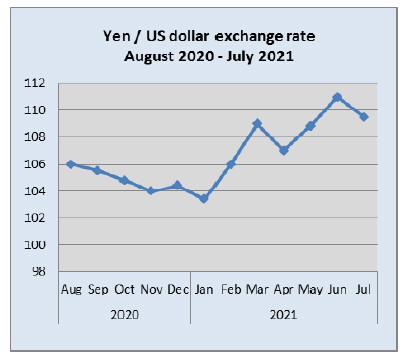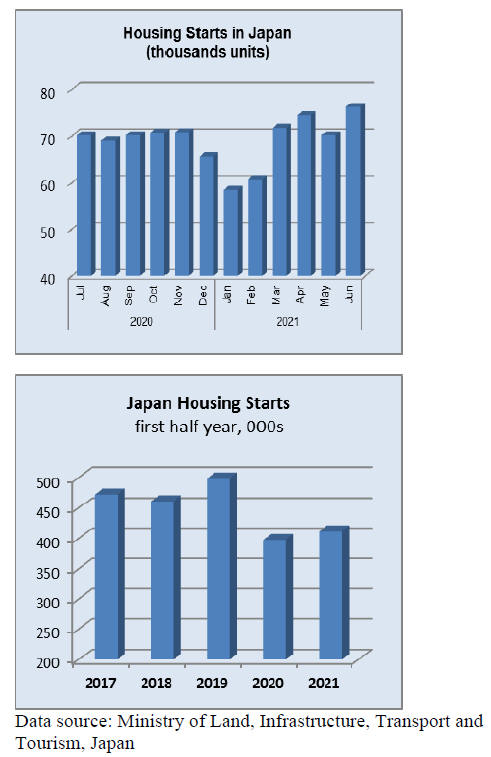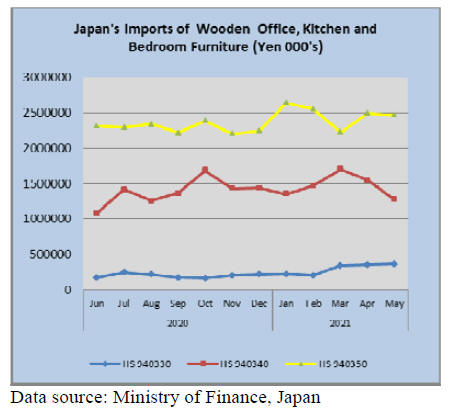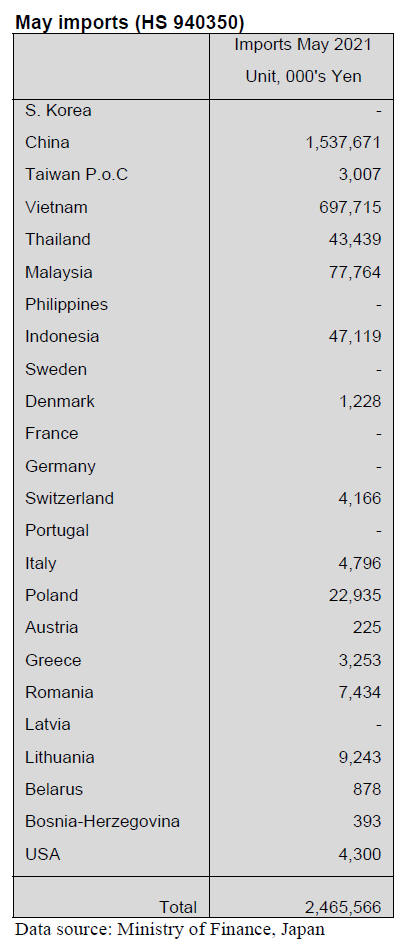Japan
Wood Products Prices
Dollar Exchange Rates of 25th
Jul
2021
Japan Yen 110.55
Reports From Japan
Optimism abounds ¨C economic
recovery this year says
government
In its July assessment of economic trends the Cabinet
Office emphasised that Japan¡¯s economy has seen
increased weakness in some sectors as measures to control
the spread of the corona virus have disrupted businesses.
However, the Cabinet Office, quoting the quarterly Bank
of Japan Tankan survey, upgraded its view on corporate
business sentiment.
The government has forecast the economy will return to
pre-pandemic levels in the latter part of this year driven by
accelerated vaccine rollouts and the steady recovery of the
global economy. The Cabinet Office forecast the nation¡¯s
real gross domestic product to grow 3.7% in fiscal 2021
from the previous year. Tokyo is currently under a fourth
state of emergency and this has been extended to Chiba,
Saitama and Kanagawa which border Tokyo.
The Chief Economist at the International Monetary Fund
said, when meeting the press, that the Tokyo Olympics,
even held without spectators at most venues, will not have
a significant impact on the Fund¡¯s projections for the
Japanese economy.
This was because spending on infrastructure in advance of
the games was the biggest outlay and that has long past. In
compiling its most recent economic outlook for Japan the
Fund did not take into account the fourth state of
emergency so warned there is a further downside risk to
Japan's economic growth coming from the latest state of
emergency.
See:
https://www.imf.org/en/News/Articles/2021/07/27/tr072721-transcript-of-the-world-economic-outlook-update-press-briefing
One of the most expensive Olympics
Hosting an Olympic Games is one of the most expensive
events any country can take on and the Tokyo Games is no
exception with estimates of the total cost put at a
staggering US$20 billion by the Japanese government
auditors. This is around three times the forecast of US$7
billion when Tokyo bid for the event.
In a recent article, Kiyoteru Tsutsui, Professor and
Director of the Japan Program at the Walter H.
Shorenstein Asia-Pacific Research Center, part of the
Freeman Spogli Institute for International Studies at
Stanford University, says Japanese public sentiment can
be summed up in a single phrase ¡°Why are we doing this
now?¡±
In an Asahi newspaper survey in Japan reported over 80%
said the Games should be postponed again or scrapped.
Professor Tsutsui continued ¡°The road to the Tokyo
Olympics has been a long and winding one complicated by
COVID-19, first and foremost and various scandals. The
Japanese public has been fed up with the COVID-19
related emergency declarations and other restrictions, as
well as the slower pace of vaccination compared to other
developed countries. The perception, right or wrong, is
that the government decisions were based on whether they
help in hosting the Olympics successfully, when the focus
should be on public health and economic rescue in the
COVID environment¡±.
See:https://news.stanford.edu/2021/07/22/long-winding-road-2020-tokyo-games/
and
https://www.asahi.com/ajw/articles/14351670
Export data suggest a recovery taking shape
In June exports from Japan rose almost 50% year on year,
the fourth month of expansion. The increases have been
exaggerated by the sharp drop in exports last year due to
the pandemic however, the data does suggest a recovery
was taking shape. The problem is now by how much will
the measures adopted to slow the rate of infections in the
fourth wave impact manufacturing output.
Slight appreciation of yen against US dollar
The US dollar fell to new weekly lows against most major
currencies in late July as economic indicators came in
weaker than expected. Second quarter GDP showed the
economy grew at an annualised 6.5%, below the 8% plus
forecast.
Also, unemployment data was worse than expected. As a
result of the unexpected dollar weakness the yen
appreciated to over 109 to the dollar.

Seeds of recovery
Year on year, June housing starts rose 7% after an almost
10% year on year rise in May. There has been a steady
upward trend in the number of housing starts from the
very low level in January this year. However, looking at
the starts over the past five years it is clear there is a long
way to go before the numbers get close to levels in the
years before 2020.

Import update
Furniture imports
As is the case in most other advanced economies
consumer spending on furniture recovered quickly after
the downturn in the first quarter of 2020 when it became
apparent that the corona virus outbreak was becoming a
pandemic. In Japan imports of wooden furniture got back
on track in the second half of 2020 and since have
performed as in pre-pandemic years.
Japan suffered a serious third wave of infections which
dented consumer sentiment and the July fourth wave of
infections and associated lockdowns along with the
general disillusionment with the Olympics are having a
negative effect on consumption.

Office furniture imports (HS 940330)
Imports of wooden office furniture picked up in March
this year and the rise was sustained for two additional
months to May 2021. Year on year, May 2021 wooden
office furniture imports were up 70% and compared to
May 2019, pre-pandemic, there was a 65% rise in May
2021.
The top three shippers of wooden office furniture in May
this year were China, France and Thailand. Shippers in
France and Thailand have been steadily gaining market
share in Japan. On the other hand Poland and Italy, once
significant shippers have lost market share.
Exporters of wooden office furniture in China accounted
for over 65% of Japan¡¯s imports of wooden office
furniture followed by France (34%) and Thailand (3%).
The top three shippers saw shipments rise in May
compared to a month earlier.

Kitchen furniture imports (HS 940340)
The slowdown in wooden kitchen furniture imports
recorded in April extended into May. Given the much
lower level of the value of imports in May 2020 it is not
surprising that year on year the value of May 2021 imports
were almost 50% up on May 2020. In comparison to prepandemic
May 2019 Japan¡¯s imports of wooden kitchen
furniture were down around 10%.
All three of the main suppliers, the Philippines, Vietnam
and China saw May imports drop below levels reported for
April. The Philippines was the top shipper, accounting for
48% of May 2021 arrivals followed by Vietnam (34%)
and China (9%). Of note was the sharp rise in the value of
wooden kitchen furniture from Germay and Malaysia.

Bedroom furniture imports (HS 940350)
The value of May 2021 imports of wooden bedroom
furniture was little changed from that a month earlier and
for the year to May is running at average levels seen over
the past 2 years. Year on year, the value of May 2021
imports of wooden bedroom furniture were up 27% and
caompared to May 2019 there was an almost 15%
increase.
The top three shippers accounted for over 90% of May
shipments of wooden bedroom furniture to Japan.
Shippers in China accounted for 62% of May imports (up
from a month earlier), Vietnam 28% (down from a month
earlier) and Malaysia 3% (down slightly from a month
earlier). While shipments of wooden bedroom furniture
from Indonesia are still small there was a significant rise
in the value of May imports.

Trade news from the Japan Lumber Reports (JLR)
The Japan Lumber Reports (JLR), a subscription trade
journal published every two weeks in English, is
generously allowing the ITTO Tropical Timber Market
Report to reproduce news on the Japanese market
precisely as it appears in the JLR.
For the JLR report please see:
https://jfpj.jp/japan_lumber_reports/
Price increase of domestic softwood plywood
Supply of structural softwood plywood is getting tight by
active demand of precutting plants and wholesalers. The
manufacturers¡¯ inventory is trending low. The
manufacturers are not able to increase the production
because of manpower shortage. Log prices climbed to
supplement shortage of imported materials so the
production cost is climbing. The manufacturers have
started proposing 1,050 yen per sheet (12 mm thick/3x6)
since 1 July.
Recutting plants have been restricting taking orders
because of shortage of building materials but orders for
structural plywood has not decreased. Wholesalers say that
sales are active so that there is very little time to store the
inventory at warehouses.
Non-structural plywood demand is also vigorous by
declining supply of South Sea hardwood plywood.
Floor manufacturers demand more supply to replace
imported hardwood plywood and sales of softwood
concrete forming panel for DIY stores are increasing.
Domestic softwood plywood manufacturers are running
fully but the production has not increased because of
restriction of overtime works by law and competition to
acquire material logs is getting fierce. Demand of cedar
logs increased and sawmills buy suitable logs for plywood
then cedar logs are now shipped for China so sudden
increase of demand for cedar logs so log purchase by
plywood mills is not easy.
Particularly in the Western Japan, demand for lumber and
export is very active so that plywood mills are not able to
buy enough locally so that they buy logs from far places
like Hokkaido and the North East Japan.
At the end of April, the manufacturers¡¯ inventory was
92,300 cbms, 10,300 cbms less than March. May has
many holidays so further decline of inventory is certain so
the manufacturers ship out produced plywood right after it
is made.
Presently market prices of structural softwood plywood
(12 mm/3x6) are 980-1,000 yen per sheet and in the
Western Japan, the supply is tighter so that the prices are
over 1,000 yen. Now the manufacturers are proposing 50-
70 yen higher prices.
Overheating market of cypress logs
Supply shortage of imported wood products triggered
demand shift to domestic logs and lumber and the prices
have been soaring sharply.
Cedar log market is now pausing before rainy season but
cypress log prices continue climbing in the Western Japan,
where there are many cypress cutting sawmills.
Despite rainy season, high prices stimulate cypress log
production. Volume of cypress is much smaller than cedar
so sawmills try to buy as much as possible before log
production slows down.
Cypress lumber prices are about 62,000-65,000 yen all
over Japan up until early March on both KD 105 mm post
and sill then the prices soared to 120,000-130,000 yen in
Kanto market by early June. Sawmills have flood of orders
and with high lumber prices, they keep paying high prices
for logs so the log prices skyrocketed all over Japan after
April.
Particularly in Western Japan and Kyushu, the prices are
extraordinary high. A number of cypress cutting sawmills
and plywood mills increased but the log supply is limited
so it has been chronic of tight supply of cypress logs then
the demand expanded all of a sudden so the prices keep
climbing.
Cypress log prices were about 20,000-22,000 yen in late
May on 4 metre sill cutting logs, which moved up to
25,000-28,000 yen in late May. The prices further climbed
to 30,000 yen or higher in June. In late June, at auction
market in Shikoku, cypress log prices marked 40,000 yen.
In this market, the prices were about 23,000 yen in last
April and May. The prices advanced to 27,000 yen in early
June and jumped up to 35,000 yen in middle of June and
finally reached 40,000 yen in late June.
After rainy season is over, log production should increase
but the supply will not be enough to satisfy booming
demand. In Hita, Kyushu, auction prices for sill cutting
cypress logs reached 40,000 yen and in Kumamoto,
Kyushu, cypress log prices are 39,000 yen.
Some sawmill owner bought cypress logs ate 40,000 yen
and said that manufacturing KD 105 mm lumber with
40,000 yen logs means lumber price should be about
140,000 yen with 50% recovery, KD cost and
transportation cost. Cypress sawmills need to increase the
sales prices of lumber in July to cover high log prices.
This is extraordinary market that cypress log prices
skyrocketed and doubled in two months.
Plywood
Both domestic and import plywood are tight in supply.
Movement of domestic softwood plywood continues
active despite slowdown of precutting companies¡¯
operations. In wholesale channel, inquiries on softwood
plywood are strong. Main orders are to fill in declining
inventory but there is some demand as substituting
materials.
Domestic plywood manufacturers increase the sales prices
because of higher log cost. Supply tightness of imported
plywood remains unsolved. Manufacturing plywood mills
in Malaysia and Indonesia struggle to secure logs but
shipment of contracts made after July will be shipped after
October so considering rainy season in the fourth quarter,
any sizable supply increase is unlikely.
Log supply in Indonesia is improving but because of
robust demand of other markets, Japan volume is very
limited. In Japan, distributors are chasing necessary items
in low inventory but fortunately construction activities are
slow so there is no impact to construction activities.
Domestic logs and lumber
Short supply of imported wood products and climbing
prices continue so substituting demand for domestic wood
also continues. There are very active orders of lumber but
production cannot increase in short time so short supply
and high prices continue.
The market in Western Japan started climbing since
early
May and speed of price increase got faster in June and
July. Particularly cypress log prices jump up by 10,000
yen every month and finally the prices reached 40,000
yen. There has not been any such high price on standard
grade cypress logs before. Meantime, in Kanto market,
where the prices started climbing since last April, the
market simmered down in June and the high prices
stopped climbing.
Normally in rainy season, log production declines but this
year, high prices stimulate log production even in rainy
season. There are more rainy days in July so log
production is slowing down and some sawmills with
minimum inventory are concerned to log supply.
Meantime, Kanto market, which led price increase of
domestic logs and lumber, upward momentum is easing in
June. 3 metre KD cedar 105 mm post prices were 52,000-
53,000 yen per cbm until last March are now 110,000-
120,000 yen. 4 metre KD cypress 105 mm sill square
prices were 62,000-63,000 yen in March are now 120,000-
130,000 yen. The prices doubled in two months then
leveling off in July.
Sawmills and dealers wish that high prices should stay
since all the imported materials are over 100,000 yen.
Wood procurement policy by Daiwa House
Daiwa House (Osaka) drew up wood procurement policy
on June 16. Purpose is to stop destruction of the forest as a
result of procuring wood to build houses. Purchase of
wood must be made through suppliers whose policy is
zero forest destruction. Also the suppliers must consider
safety and right of native workers of producing countries.
Daiwa House has started purchasing wood with policy of
no destruction of forest since 2010 and made survey of
suppliers since January 2011 and evaluate each supplier
with ranking. They are classified with four ranking, S,A,B
and C. Wood purchase from S rank, which is least risky
suppliers, was about 87% in 2015 then moved up by about
94%. A is 3.9% and B is 1.2% then C is 0.8%.
S rank is certified either by FSC or PEFC, Sustainable
Green ecosystem Council (SGEC) or sustainable supply
and legality is certified suppliers.
Daiwa House has long term environmental vision
¡®Challenge zero 2055¡¯. It is aiming zero environmental
load and one of themes is to achieve zero forest
destruction which is caused by purchase of wood for
construction of houses.
Initially it applied to purchase of structural materials, floor
panel, wall panel and furring strips but now concrete
forming plywood, interior fittings and wall cloth are
covered now.
Active log exports to China
The price of logs to China has been US$170-US$180
(C&F, cubic metres). It continues good business to export
logs to China and estimated prices may be US$190 (C&F,
cubic metre) in this month, the exporting companies say. It
is difficult to get profit because of increasing freight and
competition at a market even though yen exchange is
stable around ¥110 for US$1.Cedar logs, 4¡Á8 cm for
fences, to China and the U.S.A is very popular recently so
that causes high prices trading.
The price of radiata pine logs for China from New
Zealand, as an indicator, is nearly US$200(C&F, cubic
metres). Due to COVID-19, there are many ships
remained idle at Changshu harbor in China and it takes a
lot of time to unload.
Usually the FOB prices of Japanese logs at shipping ports
are around US$11,000 but it may increase up to ¥14,000-
¥15,000 when several exporting companies compete at a
market.
In recent few months, since there are a lot of demands for
housing in overseas, it is difficult to buy logs around
¥10,000 any longer. That makes some traders worried.
The prices of logs in Japan are ¥10,000-¥11,000 at loading
ports. If you buy logs at open market, the price might be
expensive because of competition by many companies. So
that is why the profit of exporting companies is not good
enough. On the other hand, log suppliers are happy with a
high price for even low quality logs, which are used for
biomass fuel.
People who involved with biomass energy of wood chips
are concerned about there will be not enough wood chips
if exporting logs to China keeps going since there are new
operation of biomass energy facilities which consume
wood chips.
|